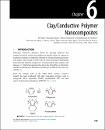Clay/Conductive Polymer Nanocomposites
الملخص
This chapter describes the main strategies for designing clay nanocomposites of the most investigated inherently conductive polymers, namely, polypyrrole, polyaniline, and polythiophenes including poly(3,4-ethylenedioxythiophene) polystyrene sulfonate. It is shown that premodification of clays is an essential step to successful intercalation or exfoliation by conductive polymers. Toward this end, surfactants, reactive diazonium, and silanes permit the preparation of adhesive clay sheets for the conductive polymers once polymerization is triggered. Exfoliated nanocomposites usually exhibit superior properties compared to intercalated ones. Through selected applications (e.g., conductive fillers, catalysts, sensors, ultracapacitors), it is clear that research on clay–conductive polymer nanocomposites will continue to grow because these materials combine the best of two worlds: low-cost abundant minerals with remarkable nanostructural properties and nanostructuring abilities on the one hand and ease of synthesis, reactivity, and electrical conductivity of conjugated polymers on the other hand.
المجموعات
- الأبحاث [1633 items ]



